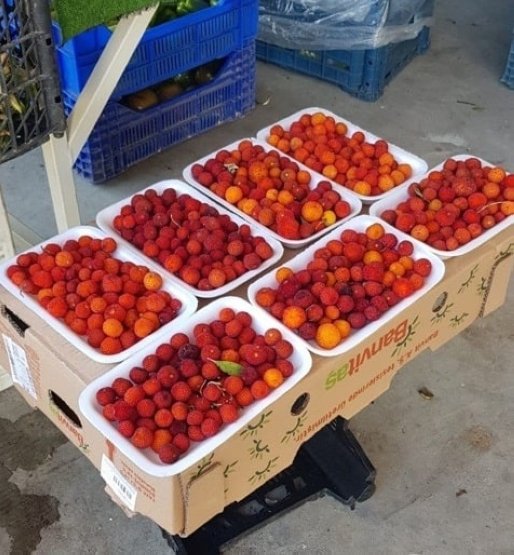
Türkiye’s culinary traditions are very much based on the seasons; thus, there is special produce that pops up in winter that may be unfamiliar to foreigners. Let this be your guide to the special products you can try in winter here and how to consume them
Türkiye’s cuisine and farmers markets are famous for their seasonality and having a wide range of fruits and vegetables, which definitely comprise one of the perks of living healthy in this country. In winter especially, there are a number of lesser-known fruits that are especially revered for their nutritional benefits. Some are consumed as is, while others are made into jams and marmalades, and some are even turned into pickles!
Check out some of the special fruits to savor this winter season.
Bergamot
Not everyone may know that the citrus fruit bergamot is the main aroma of the type of tea more regularly referred to as Earl Grey. It is traditionally a mixture of black tea and bergamot oil, which is what imparts its telltale flavor. Well in Türkiye, the citrus fruit bergamot, which resembles a large and bumpy lemon, is actually readily available at farmers' markets and it is used to make herbal tea and marmalade. While if one assumes it is the pulpy center of the fruit used in such preparations, they would be wrong. The center of the fruit is actually quite sour, and while occasionally used in lieu of lemon to dress salads, it is actually the rind that is the most valuable part of the bergamot in terms of its preparation.
How Turks prepare their own form of bergamot tea is to peel off the external yellow rind and dry it. Solely the yellow part of the rind is used in the preparation of the fruit as tea and it is peeled off into small pieces that are then dried over a week to 10 days. Due to this fruit’s winter seasonality, it is not advised to dry the rinds outdoors, but to instead lay them on a tray indoors so they do not acquire moisture, tossing and turning them every few days. Afterward, the rinds are simply added to boiling water, and Voila! You then have your very own bergamot tea with a similar aroma to the more well-known Earl Gray. Bergamot is also believed to reduce inflammation, lower cholesterol and increase serotonin and dopamine.

The marmalade preparation of the fruit is slightly more complicated. While the yellow rinds can be added to provide extra aroma, the majority of the marmalade consists of the thicker skin that lies beneath protecting the fruit’s pulpy center. These thicker white rinds are boiled for 20 minutes after which they are left to soak in cold water for two days. During this period, the water should be replaced approximately eight times. A sherbet consisting of sugar and water is then brought to a boil and the bergamot rinds are cut into bite-sized pieces and boiled for 30 minutes. The rind pieces will then take on a clear consistency, and citric acid or lemon juice is added to complete the marmalade prepping process.
What are people picking?
Wild strawberries are a fruit referred to as "dağ çileği" (mountain strawberry) or "koca yemiş" in Turkish and are found on a shrub-like tree that can grow from 5 to 10 meters (around 15 to 30 feet) in height. Consumed for its high concentration of vitamin C, it is eaten whole as a fruit that is quite sweet in taste and soft and fuzzy in consistency, and comes in bright orange and red hues.
Kumquat, spelled Kumkuat in Turkish, is a walnut-sized bitter-sweet fruit that is consumed as is, prepared as a jam and more interestingly, pickled! Contrary to the norm, the rind of the peachy-orange colored fruit is sweet, while the juicy and small-seeded center is somewhat bitter and considerably fragrant. Most prevalently found in Türkiye’s Mediterranean region, the fruit is eaten for its benefits to the eyes, teeth, being an antiseptic, lowering cholesterol and blood sugar as well as being rich in vitamin C.
To make kumquat jam, it is essential to boil the fruit and then transfer it to a fresh vat of water, and let them soak to reduce the bitterness. Cold water is then placed and replaced a number of times over the course of a few hours. The preserves are made using the same proportion of fruit to water and sugar and then, interestingly enough to make the jam shiny, a Turkish teaspoonful of butter is added to the jam mixture, which also consists of a few cloves.
Myrtle is a berry that looks deceivingly similar to blueberries, but anyone who takes a bite into one will quickly understand that the two differ significantly. Referred to regionally as either mersin, murt or hambeles, the fruit comes in the telltale deep blue color or in a light whitish-yellow variety. The taste of myrtle berry is quite aromatic and veering toward perfumy, while the berry’s center consists of tiny little seeds that are almost powder-like when chewed. Picked from shrubs in the Mediterranean, Aegean and Marmara regions, the fruit is consumed whole and revered for its health benefits. They are said to have antiseptic and expectorant qualities and are good for the circulatory system and veins. They are thus believed to even be beneficial in shrinking varicose veins.
